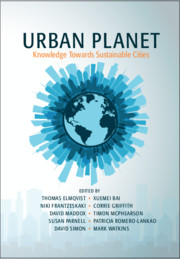There has recently been a rapid decrease in the amount of open and natural space in Japan, and urban areas are particularly affected due to development. This has caused a decrease in the space available for children’s physical play in natural environments (Ito et al. Reference Ito, Fjørtoft, Manabe, Masuda, Kamada, Fujiwara, Muller, Werner and Kelcey2010). These are pressing issues; children’s play is crucial for learning about the structure of nature and is an essential aspect of environmental education. Indeed, early studies by American environmental psychologists described the value of complex environments and wild lands for children, and how children perceive and experience wild lands as places of their own domain (for example, see Hart Reference Hart1979 and Moore Reference Moore1986).
Children build relationships with landscape areas by having direct, hands-on interaction with vegetation during play and participation. The greening of school grounds increases the diversity of children’s school ground use, including more opportunities for pretend play. However, it could be even more beneficial and successful if children are included in the planning and long-term care of these spaces, from preliminary planning to assisting with ongoing maintenance. This would promote positive attitudes and caring behavior among children towards outdoor spaces as well as improve plant establishment.
If we convert even relatively small concrete structures in an urban area into functioning biotopes, they will also serve as stepping-stones for environmental and ecological education. Landscape diversity is related to different structures in topography and vegetation, which is important for children’s spontaneous play and activities. School biotopes are created using many different methods. Some have been successful, while many have failed and been abandoned. In Japan, many school biotopes have been constructed. The main aim of school biotopes is to provide ecological education for the children in urban areas. Some of them have been successful and were created in collaboration with children, teachers, planners, and people in the region; all use the space freely, as they want. However, there are some biotopes that have not been maintained and are ultimately abandoned. There are several reasons why such biotopes fail. First, children are not allowed to utilize the biotope due to an emphasis on its protection rather than its use. Second, planners fail to consider the larger regional ecosystem, which can lead to more harm than help. Third, the biotope is too small to have an ecological function. Finally, children and teachers do not use the biotope because it was planned and constructed by the local council without their participation (Ito et al. Reference Ito, Sudo and Fjørtoft2016).
One successful project was created in Fukuoka, a city in the south of Japan. The aim of this project was to create an area for children’s play and ecological education that could form part of an ecological network in their local urban area. The school actively sought to involve their students in the planning process in order to avoid the aforementioned problems. It aimed to create a place for children that could be easily approached, that safely utilized local flora, and that could help rehabilitate the regional ecosystem (Ito et al. Reference Ito, Sudo and Fjørtoft2016). As a result of this decision, children were able to freely use the space and felt more invested in its upkeep and use.
It is vital that planners and landscape designers consider landscape as an “Omniscape” (Numata Reference Numata1996; Ito et al. Reference Ito, Sudo and Fjørtoft2016) in which it is much more important to think of landscape planning as a “learnscape,” embracing not only the joy of seeing, but an exciting, more holistic way of using the body and senses for learning. Thus, it is very important to observe how children and teachers use their school’s biotope, which can help landscape designers and planners to create a plan that caters to their needs. Giving children more experiences with nature during their formative years creates more diverse cultures and biodiversity, even in urban areas.

